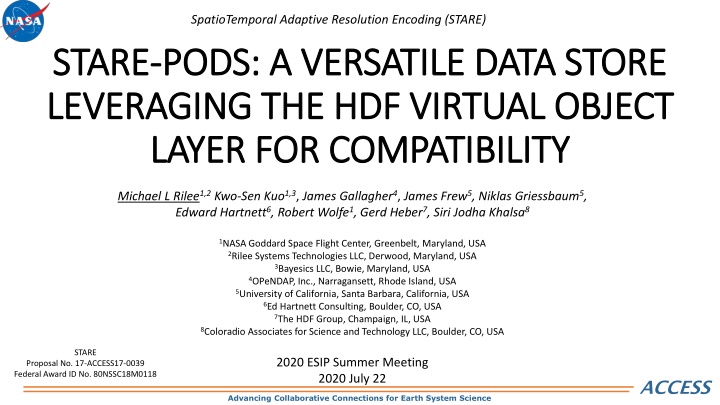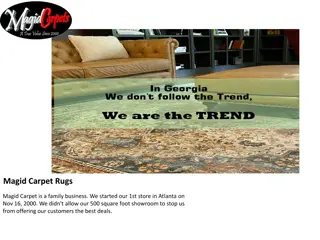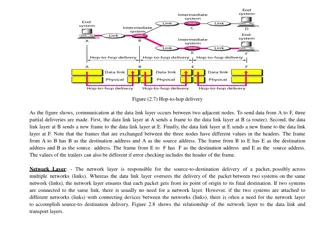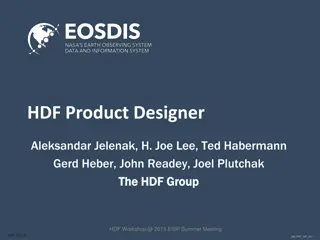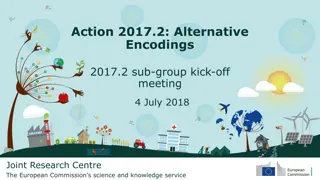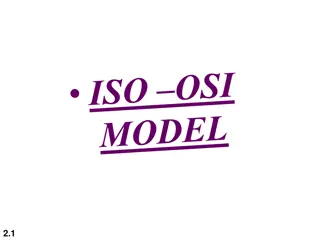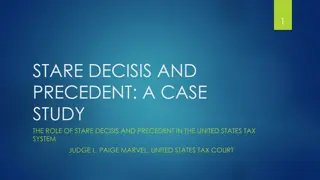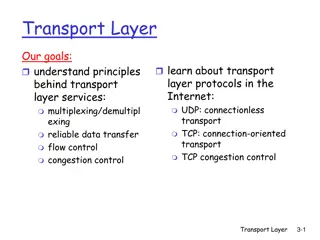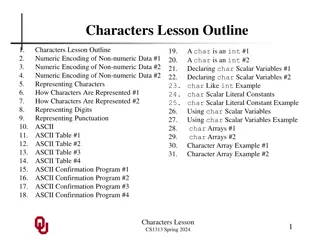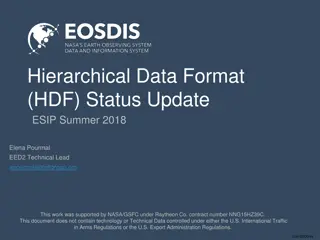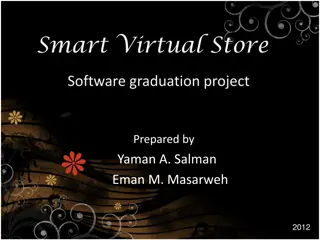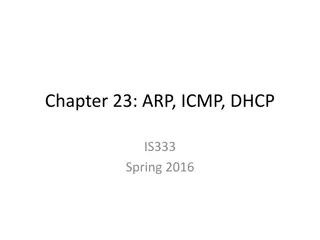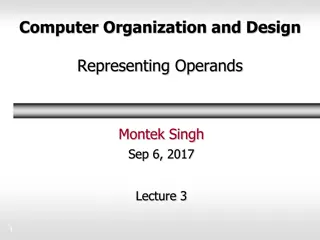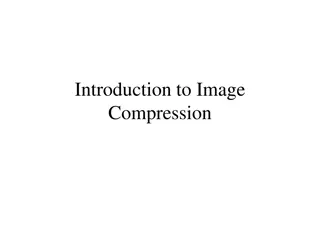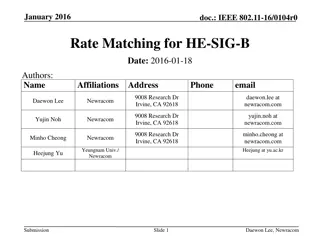SpatioTemporal Adaptive Resolution Encoding (STARE): A Versatile Data Store Leveraging HDF Virtual Object Layer
STARE-PODS is a proposal by a team of experts aiming to provide a unifying indexing scheme for combining diverse Earth Science data. Leveraging the SpatioTemporal Adaptive Resolution Encoding (STARE) and Parallel Optimized Data Store (PODS), the system enables efficient processing and analysis of geo-located data. By utilizing HDF's Virtual Object Layer (VOL) and Virtual Data Set (VDS) technologies, STARE-PODS simplifies accessing and integrating complex Earth Science datasets, offering scalability and minimizing duplication.
Download Presentation

Please find below an Image/Link to download the presentation.
The content on the website is provided AS IS for your information and personal use only. It may not be sold, licensed, or shared on other websites without obtaining consent from the author.If you encounter any issues during the download, it is possible that the publisher has removed the file from their server.
You are allowed to download the files provided on this website for personal or commercial use, subject to the condition that they are used lawfully. All files are the property of their respective owners.
The content on the website is provided AS IS for your information and personal use only. It may not be sold, licensed, or shared on other websites without obtaining consent from the author.
E N D
Presentation Transcript
SpatioTemporal Adaptive Resolution Encoding (STARE) STARE STARE- -PODS: A VERSATILE DATA STORE PODS: A VERSATILE DATA STORE LEVERAGING THE LEVERAGING THE HDF HDF VIRTUAL OBJECT LAYER FOR COMPATIBILITY LAYER FOR COMPATIBILITY VIRTUAL OBJECT Michael L Rilee1,2 Kwo-Sen Kuo1,3, James Gallagher4, James Frew5, Niklas Griessbaum5, Edward Hartnett6, Robert Wolfe1, Gerd Heber7, Siri Jodha Khalsa8 1NASA Goddard Space Flight Center, Greenbelt, Maryland, USA 2Rilee Systems Technologies LLC, Derwood, Maryland, USA 3Bayesics LLC, Bowie, Maryland, USA 4OPeNDAP, Inc., Narragansett, Rhode Island, USA 5University of California, Santa Barbara, California, USA 6Ed Hartnett Consulting, Boulder, CO, USA 7The HDF Group, Champaign, IL, USA 8Coloradio Associates for Science and Technology LLC, Boulder, CO, USA STARE 2020 ESIP Summer Meeting 2020 July 22 Proposal No. 17-ACCESS17-0039 Federal Award ID No. 80NSSC18M0118 ACCESS Advancing Collaborative Connections for Earth System Science
STARE STARE- -PODS PODS for scalable Analysis Ready Data (ARD) Diverse low-level Earth Science data (ESD) requires special treatment to co-align and combine for integrative analysis The SpatioTemporal Adaptive Resolution Encoding (STARE) provides a unifying indexing scheme to combine geo-located ESD STARE partitioned ESD enables Parallel Optimized Data Store (PODS) HDF s Virtual Object Layer (VOL) and Virtual Data Set (VDS) technologies can provide familiar front-ends to data in STARE-PODS STARE-PODS unifies accessing diverse data with minimum duplication STARE-PODS is a proposal to NASA/ACCESS-19 currently under review. ACCESS Advancing Collaborative Connections for Earth System Science
STARE Basics ACCESS Advancing Collaborative Connections for Earth System Science
STARE Basics Existing native array & memory indexing impedes integration and processing. ACCESS Advancing Collaborative Connections for Earth System Science
Parallel & distributed indexing based on native array partitioning leads to extra data movement, breaking SCALABILITY. Higher-res nadir Lower-res wing Region of interest Two swath sections, A and B, overlap with the region of interest (ROI) outlined in black, with data on separate computational nodes (numbered). ACCESS Advancing Collaborative Connections for Earth System Science
STARE Encoding a locations in a recursive spatial quad-tree A tilted root polyhedron 0th level STARE Spatial Trixels Encoded as 64-bit integers First refinement level 1st level STARE Temporal indexing is similar but based on calendrical periods. ACCESS Advancing Collaborative Connections for Earth System Science
STARE Spatial Hierarchical Triangular Mesh (HTM) Indexing: spherical triangles to integers via quadtree recursion - aids comparison of different data sets, integer operations are much faster than geometric calculations - bit pattern keeps co-located data together when chunked STARE Temporal Hierarchical Calendrical Partitioning (HCP): similar but with branching based on calendar partitions Levels N3333 level Bit 1 1 11 11 11 11 -> 0xffc (right justified) N3333 ffc0000000000000 @level 3 (left justified) 1 2 3 00 3 01 10 N33330-N33333 N33330 ffc0000000000000 @level 4 l N33333 fff0000000000000 @level 4 11 01 0000 10 11 4 00 1100 N333300-N333333 N333300 ffc0000000000000 @level 5 l N333333 fffc0000000000000 @level 5 0011 1111 5 Chunk 1 ffc0-ffcc Chunk 2 ffd0-ffdc Parallel Store, SciDB Chunk 4 fff0-fffc Chunk 3 ffe0-ffec @level 5 Worker Node 1 1 Worker Node 2 2 Worker Node 3 3 Worker Node 4 4 Worker Node Worker Node Worker Node Worker Node ACCESS Chunks Advancing Collaborative Connections for Earth System Science
STARE vs Floating-Point Encoding Longitude Latitude Human readable +123.4 60 Single-precision floating-point 0x42f6cccd 0x42700000 STARE id* 0x36ee9398f7210f34 *STARE id also includes resolution information. In this case, it points to quadfurcation level 20, i.e. 10m The smallest triangle in the figure is at quadfurcation level 6. ACCESS Advancing Collaborative Connections for Earth System Science
Supporting conventional lon-lat vs. STARE-based integration MODIS STARE indexing adapts to the resolution of the data, which often varies. One scan with ten sensors. MODIS pixel (nadir resolution) Lon-lat search area for combining data GOES pixel WING NADIR ACCESS Advancing Collaborative Connections for Earth System Science
2+1 Dimensions indexed with two integers STARE SpatioTemporal Search/Index VolumesHurricane IRMA Key West Sensor trajectory Cuba STARE Volumes (not to scale) ACCESS Advancing Collaborative Connections for Earth System Science
Parallelization for Volume & Variety Scaling ACCESS Advancing Collaborative Connections for Earth System Science
STARE supporting a 16-way partitioning co-locating diverse data ACCESS Advancing Collaborative Connections for Earth System Science
Using STARE to combine GOES and MODIS data Can use key-value store to integrate GOES (red/brown) and MODIS (blue) granules integrated using STARE (visualized in equirectangular projection) ACCESS Advancing Collaborative Connections for Earth System Science
Using STARE to combine GOES and MODIS data Can use key-value store to integrate GOES (red/brown) and MODIS (blue) granules integrated using STARE (visualized in equirectangular projection) ACCESS Advancing Collaborative Connections for Earth System Science
HDF Virtual Object Layer and Virtual Data Sets ACCESS Advancing Collaborative Connections for Earth System Science
Scalable Homogenized Analysis Ready Data Store (STARE-SHARDS) HDF Virtual Data Set API Usability HDF Virtual Data Set for tailoring views into the data Actual data partitioned into chunks for parallelism with unified search and co-alignment. Individual instrument field of views Volume & variety scalability ACCESS Advancing Collaborative Connections for Earth System Science
Scalable Homogenized Analysis Ready Data Store (STARE-SHARDS) HDF Virtual Data Set API Usability HDF Virtual Data Set for tailoring views into the data STARE-SHARDS Storage Layer Actual data partitioned into chunks for parallelism with unified search and co-alignment. Individual instrument field of views Volume & variety scalability ACCESS Advancing Collaborative Connections for Earth System Science
Using familiar HDF methods to access STARE-SHARDS End users and legacy applications interact with STARE-SHARDS transparently. STARE partitioned swath data looks like familiar HDF files HDF Virtual Granule Use a STARE cover to partition a granule Different sources and varieties of data with different coverage, resolutions Data Source A Data Source 2 Data Source B Data Source 3 Data Source 1 ACCESS Advancing Collaborative Connections for Earth System Science
Using familiar HDF methods to access STARE-SHARDS End users and legacy applications interact with STARE-SHARDS transparently. STARE partitioned swath data looks like familiar HDF files HDF Virtual Granule Use a STARE cover to partition a granule Different sources and varieties of data with different coverage, resolutions Data Source A Data Source 2 Data Source B Data Source 3 Data Source 1 ACCESS Advancing Collaborative Connections for Earth System Science
The Proposed Architecture STARE SHARDS to PODS to Integrative Analysis Use & Tooling Query, Marshalling, Transport Index & Organization Computing & Storage ACCESS Advancing Collaborative Connections for Earth System Science
The Architecture STARE SHARDS to PODS to Integrative Analysis STARE Location Service (SLS) A DNS for geolocated data ACCESS Advancing Collaborative Connections for Earth System Science
Conclusion: STARE Conclusion: STARE- -PODS for scalable integrative analysis PODS for scalable integrative analysis STARE lays the foundation for scaling both variety and volume Supports lower-level (L1 & L2) data accessibility, combination, and scalability Features C++ and Python APIs, including a Pandas-like interface STARE Sidecar files limit costs of translation into STARE indices OPeNDAP integration is in progress Libraries, examples, tests, and cookbooks at https://github.com/SpatioTemporal STARE-PODS and STARE-SHARDS Organize diverse data for co-alignment and parallel/distributed storage and processing HDF Virtual Object Layer and Data Set support transparent legacy access Acknowledgments STARE-PODS is a proposal to NASA/ACCESS-19 currently under review. This work is supported by NASA/ACCESS-17. Federal Award ID No. 80NSSC18M0118. NASA/LaRC for interest and support. ACCESS Advancing Collaborative Connections for Earth System Science
Supplemental ACCESS Advancing Collaborative Connections for Earth System Science
ACCESS Advancing Collaborative Connections for Earth System Science
NASA/ACCESS-17-39 STARE 80NSSC18M0118 M. Rilee mike@rilee.net Rilee Systems Technologies LLC 2019 October 21 ACCESS Advancing Collaborative Connections for Earth System Science
NASA/ACCESS-17-39 STARE 80NSSC18M0118 M. Rilee mike@rilee.net Rilee Systems Technologies LLC 2019 October 21 ACCESS Advancing Collaborative Connections for Earth System Science
Zooming in to the MODIS swath bow-tie Two scans overlapping WING NADIR STARE Indexing adapts to the data ACCESS Advancing Collaborative Connections for Earth System Science
ROI+GOES ROI+MODIS ROI+GOES+MODIS A D C B STARE Spatial IDs Level 5, green trixels A 0x1048000000000005 B 0x104a000000000005 C 0x104c000000000005 D 0x104e000000000005 0x1049e66dab30632b 0x1048000000000005 NASA/ACCESS-17-39 STARE 80NSSC18M0118 M. Rilee mike@rilee.net Rilee Systems Technologies LLC 2019 October 24 ACCESS Advancing Collaborative Connections for Earth System Science
NASA/ACCESS-17-39 STARE 80NSSC18M0118 M. Rilee mike@rilee.net Rilee Systems Technologies LLC 2019 October 21 ACCESS Advancing Collaborative Connections for Earth System Science
ROI+MODIS ROI+GOES ROI +GOES +MODIS A: 0x1049e6000000000a B: 0x1049e6600000000b C: 0x1049e66dab30632b NASA/ACCESS-17-39 STARE 80NSSC18M0118 M. Rilee mike@rilee.net Rilee Systems Technologies LLC 2019 October 24 ACCESS Advancing Collaborative Connections for Earth System Science
Instrument Field of View and Point Spread Function Modeling Integration at the finest level via IFOV and PSF modeling k blue psf j brown psf ?? ????? ????? i ? = ? ? combined Signal (target) Observation Vectors (source) PSF weights Finer trixels not shown for clarity. ACCESS Advancing Collaborative Connections for Earth System Science
ACCESS Advancing Collaborative Connections for Earth System Science
